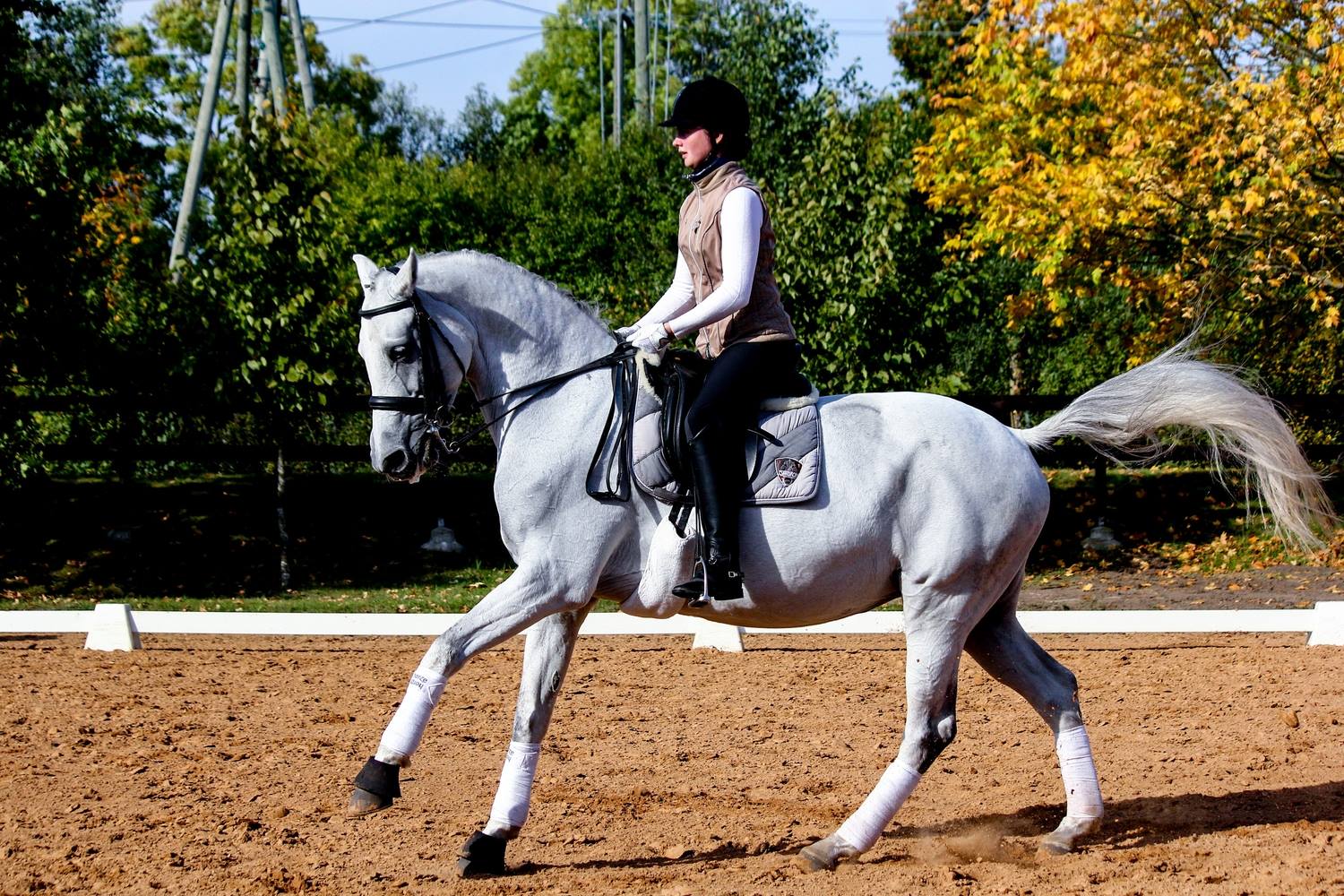
)
In this photo, Sabine Anne Irbe is riding her horse Dina, a 14-year-old Belgian Warmblood. They are competing at the Young Rider level together, and from my understanding, they are from Latvia.
This picture radiates a lot of positive energy. You can see how Dina is working with the muscles in her hindquarters and she appears fully concentrated on her job. Swishing the tail, of course, can suggest some tension in the back, and this often happens when performing some higher-level movements, such as working on changes and more collection. It’s almost as if the horse needs to use the tail to increase the power from behind. If tail-swishing happens continuously during the work, it needs to be checked out by a professional, but only once may just be caused by a fly.
Dina shows nice self-carriage and an uphill tendency in her shoulders and canter. Her mouth shows some white foam, and the contact and angle of the curb bit look like a light and nice connection to her rider’s hands.
Sabine sits nicely focused, straight forward, with a slight forward tendency in her upper body and a very correct hand and arm position. I prefer a slightly forward upper body in canter to an upper body that gets left behind the movement, which disturbs the horse much more.
When I ask myself what I would now teach to further improve this well-matched team, Sabine’s pelvis position and connection come to mind. I would like her to connect her pelvis better to the movement of her horse’s canter so that Dina can better connect between her hindquarters and shoulders to develop better collection in the body.
When looking at Dina’s canter stride, I see there is a significant distance between the landing of the inside (left) hind leg and the outside (right) front leg. This diagonal pair of legs is landing together in the footfall of the canter. The higher the quality of the canter stride, the better the horse can balance on this diagonal.
Try to feel how the horse needs to balance in the canter by standing up and placing one foot slightly diagonally in front of the other one. When your legs are further apart, your center of gravity is lower and it is easier to balance. The closer the legs come together, the higher your center of gravity becomes and the balance becomes more fragile. Balance on a higher level (think of a ballet dancer) is more fragile. Balance cannot be fixed or static—it will be lost and needs to be reestablished continuously. It is a mobile game!
For the horse this means that the closer she keeps her hind leg and front leg together in the canter, the more cadence the canter will have with a higher-quality balance. The rider needs to help the horse find the balance with every new stride.
Try this: Imagine that you are cantering/skipping on the ground like a horse. With every stride, your feet will land farther apart and your strides will be long and more forward. When you change the length of your strides and you skip with your second foot landing only a short distance in front of the first one, you can feel how “collecting” the canter stride will feel for the horse. Your weight will shift from a more forward direction (long strides) to more lateral strides (short strides).
Your aids in canter are very similar to this situation. Imagine that your seat bones are your feet skipping on the ground. To follow the canter movement of the horse, the rider needs to shift her weight together with the horse. The horse lands on the outside hind leg and takes off on the inside front leg. The rider’s pelvis follows this movement and during each canter stride, the outside seat bone lands first and then the weight is shifted diagonally forward to the inside seat bone. To influence the canter stride, the rider can change the direction of this shift of weight from more forward to more lateral just like when you are changing the length of skipping strides on the ground. It is often surprising how well horses can understand this tiny change in the seat and then the rider does not need more leg or rein aids to keep the canter active and more collected.
Dina’s topline appears shorter and a little hollow in the area where the rider is sitting. The bottom line (stomach) appears to be much longer. Understanding the importance of that diagonal phase in the canter, one can then easily make the connection that the open, spread-out diagonal moment that Dina shows does not help to lift the back and activate the horse’s abdominal muscle chain. Here, too, the comparison to the skipping motion can be helpful. When skipping on the ground, put one hand on your lower back and one on your tummy. When you skip with big strides, the lower back will be more hollow and the abdominal muscles less engaged. When you skip with the feet closer together (more collected skipping) the lower back will fill up more and the tummy muscles become automatically more active. The core muscles activate.
So the parallel of the rider’s shift of weight and the horse’s stride in canter can influence balance, activity and self-carriage of the horse.
Susanne von Dietze is a leader in equestrian biomechanics. A physiotherapist, licensed Trainer A instructor and judge for dressage and show jumping, she gives lectures and seminars throughout the world, including at the prestigious German Riding Academy in Warendorf. She is a native of Germany and now lives with her husband and three children in Israel, where she competes at the international level. She is the author of two books on the biomechanics of riding: Balance in Movement and Horse and Rider, Back to Back. Find her books at www.EquineNetworkStore.com.











